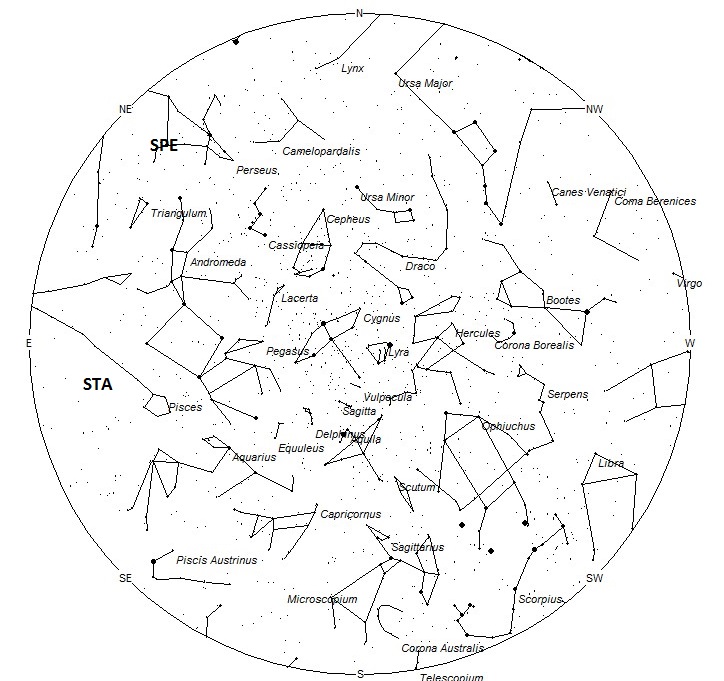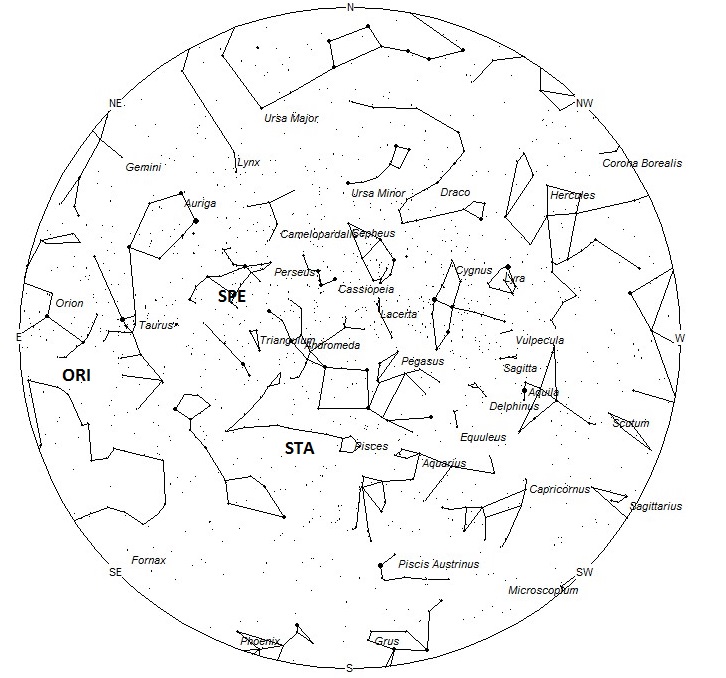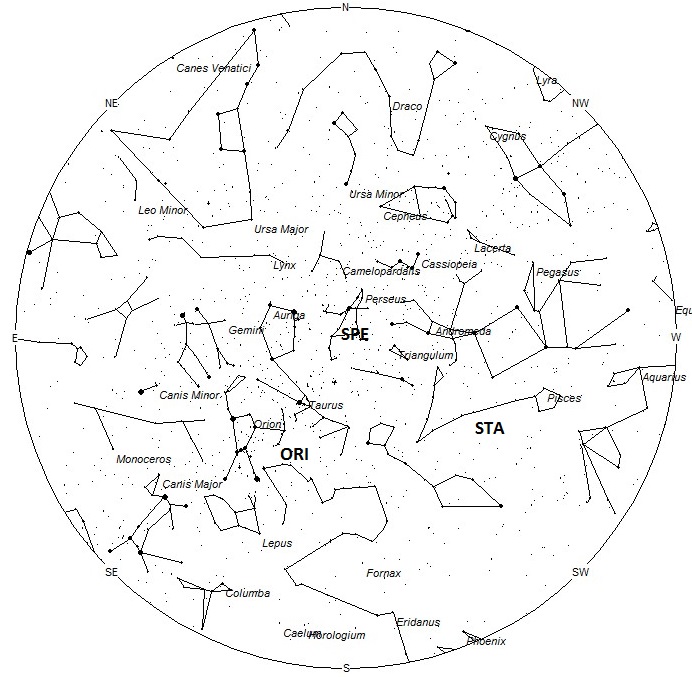
During this period the moon reaches its full phase on Friday September 16th. This weekend the half-illuminated moon will set during the early morning hours, allowing the remainder of the night to be moon-free and dark for meteor viewing. This window of darkness will decrease as the week progresses until the bright moon remains above the horizon all night long. The estimated total hourly meteor rates for evening observers this week is near 3 as seen from mid-northern latitudes (45N) and 2 as seen from tropical southern locations (25S). For morning observers the estimated total hourly rates should be near 18 as seen from mid-northern latitudes (45N) and 13 as seen from tropical southern locations (25S). Rates during this period are reduced during the evening hours due to moonlight. The actual rates will also depend on factors such as personal light and motion perception, local weather conditions, alertness and experience in watching meteor activity. Note that the hourly rates listed below are estimates as viewed from dark sky sites away from urban light sources. Observers viewing from urban areas will see less activity as only the brightest meteors will be visible from such locations.
The radiant (the area of the sky where meteors appear to shoot from) positions and rates listed below are exact for Saturday night/Sunday morning September 10/11 These positions do not change greatly day to day so the listed coordinates may be used during this entire period. Most star atlases (available at science stores and planetariums) will provide maps with grid lines of the celestial coordinates so that you may find out exactly where these positions are located in the sky. A planisphere or computer planetarium program is also useful in showing the sky at any time of night on any date of the year. Activity from each radiant is best seen when it is positioned highest in the sky, either due north or south along the meridian, depending on your latitude. It must be remembered that meteor activity is rarely seen at the radiant position. Rather they shoot outwards from the radiant so it is best to center your field of view so that the radiant lies at the edge and not the center. Viewing there will allow you to easily trace the path of each meteor back to the radiant (if it is a shower member) or in another direction if it is a sporadic. Meteor activity is not seen from radiants that are located below the horizon. The positions below are listed in a west to east manner in order of right ascension (celestial longitude). The positions listed first are located further west therefore are accessible earlier in the night while those listed further down the list rise later in the night.
These sources of meteoric activity are expected to be active this week.
We are now encountering inbound debris from comet 2P/Encke, which has a radiant superimposed upon the anthelion radiant. Since it has been shown that meteors from 2P/Encke are more numerous we shall recognize this activity as the Southern Taurids (STA) until December 5th, when the Earth no longer encounters these particles. The maximum was once thought to occur in early November when the radiant was located in Taurus. Video studies have shown that the peak usually occurs near October 10th but that there is also a period of enhancement during the last week of October and the first week of November, when the Northern Taurids are also active. The center of the large radiant is currently located near 00:24 (006) +03. This position lies in southern Pisces, 6 degrees southwest of the fourth magnitude star Delta Piscium. These meteors may be seen all night long but the radiant is best placed near 0200 local daylight time (LDT) when it lies on the meridian and is located highest in the sky. Rates at this time should be near 2 per hour regardless of your location. With an entry velocity of 29 km/sec., the average Southern Taurid meteor would be of slow velocity.
The September Epsilon Perseids (SPE) are active from the 5th through the 28th with the peak occurring on the night of September 8/9. The radiant is currently located at 03:16 (049) +41. This position lies in southwestern Perseus, just east the famous eclipsing variable star known as Algol (Beta Persei). The radiant is best placed near 0500 LDT, when it lies highest above the horizon. Rates are expected to be near 3 per hour from the northern hemisphere and near 1 as seen from south of the equator. With an entry velocity of 65 km/sec., most activity from this radiant would be swift.
You may be surprised to see the Orionids (ORI) as an active radiant this time of year, but there is clear evidence from the IMO video database that this shower is active long before its October 22nd maximum. In fact it is in the top four most active radiants throughout September. This radiant is currently located at 04:36 (069) +03, which places it in southeastern Taurus, 13 degrees due south of the 1st magnitude orange star known as Aldebaran (alpha Tauri). This area of the sky is best placed in the sky during the last hour before dawn, when it lies highest above the horizon in a dark sky. Current rates would be near 2 per hour no matter your location. With an entry velocity of 67 km/sec., most activity from this radiant would be of swift speed. Note that the established radiant known as the Nu Eridanids (NUE) are actually early members of the Orionids.
As seen from the mid-northern hemisphere (45N) one would expect to see approximately 11 sporadic meteors per hour during the last hour before dawn as seen from rural observing sites. Evening rates would be near 2 per hour. As seen from the tropical southern latitudes (25S), morning rates would be near 8 per hour as seen from rural observing sites and 1 per hour during the evening hours. Locations between these two extremes would see activity between the listed figures. Evening rates are reduced during this period due to moonlight.
The table below presents a list of radiants that are expected to be active this week. Rates and positions are exact for Saturday night/Sunday morning except where noted in the shower descriptions.
| SHOWER | DATE OF MAXIMUM ACTIVITY | CELESTIAL POSITION | ENTRY VELOCITY | CULMINATION | HOURLY RATE | CLASS |
| RA (RA in Deg.) DEC | Km/Sec | Local Daylight Saving Time | North-South | |||
| Southern Taurids (STA) | Oct 10 | 00:24 (006) +03 | 29 | 02:00 | 2 – 2 | II |
| September Epsilon Perseids (SPE) | Sep 9 | 03:16 (049) +41 | 65 | 05:00 | 3 – 1 | II |
| Orionids (ORI) | Oct 22 | 04:36 (069) +03 | 67 | 07:00 | 2 – 2 | I |
 American Meteor Society
American Meteor Society


